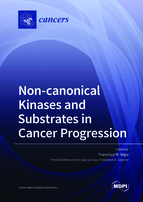Non-canonical Kinases and Substrates in Cancer Progression
A special issue of Cancers (ISSN 2072-6694). This special issue belongs to the section "Molecular Cancer Biology".
Deadline for manuscript submissions: closed (30 September 2020) | Viewed by 48989
Special Issue Editor
Interests: cancer; metastasis; adhesion; cell migration; Rho GTPases; neuroblastoma; cellular signalling
Special Issues, Collections and Topics in MDPI journals
Special Issue Information
Dear Colleagues,
Protein Ser/Thr or Tyr kinases mediate most signal transduction pathways in eukaryotic cells, being the favourite post translational modification for situations where a rapid response to extracellular or intracellular signalling is required. Many of the known oncogenic proteins are kinases and many tumour suppressor proteins are among their substrates. More than 15 years after the publication by Manning et al. of their landmark paper describing the human kinome, only a small proportion of the kinases potentially involved in cancer progression have received most of the attention. Moreover, only a few of the potential targets have been investigated in their cellular context. With an ever-pressing need for new druggable targets, the understanding of the biological function and contribution to cancer progression of the lesser known cancer-related kinases represents an unavoidable asset.
This special issue of Cancers pretends to bring together the latest views and original research on non-canonical protein kinases, substrates and scaffolds. Topics might include protein structure and regulation; scaffolding and complex formation; cellular signalling; non-canonical substrates; inhibition and targeting; biological function, etc.
Dr. Francisco M. Vega
Guest Editor
Manuscript Submission Information
Manuscripts should be submitted online at www.mdpi.com by registering and logging in to this website. Once you are registered, click here to go to the submission form. Manuscripts can be submitted until the deadline. All submissions that pass pre-check are peer-reviewed. Accepted papers will be published continuously in the journal (as soon as accepted) and will be listed together on the special issue website. Research articles, review articles as well as short communications are invited. For planned papers, a title and short abstract (about 100 words) can be sent to the Editorial Office for announcement on this website.
Submitted manuscripts should not have been published previously, nor be under consideration for publication elsewhere (except conference proceedings papers). All manuscripts are thoroughly refereed through a single-blind peer-review process. A guide for authors and other relevant information for submission of manuscripts is available on the Instructions for Authors page. Cancers is an international peer-reviewed open access semimonthly journal published by MDPI.
Please visit the Instructions for Authors page before submitting a manuscript. The Article Processing Charge (APC) for publication in this open access journal is 2900 CHF (Swiss Francs). Submitted papers should be well formatted and use good English. Authors may use MDPI's English editing service prior to publication or during author revisions.
Keywords
- protein structure and regulation
- scaffolding and complex formation
- cellular signalling
- non-canonical substrates
- inhibition and targeting
- biological function







